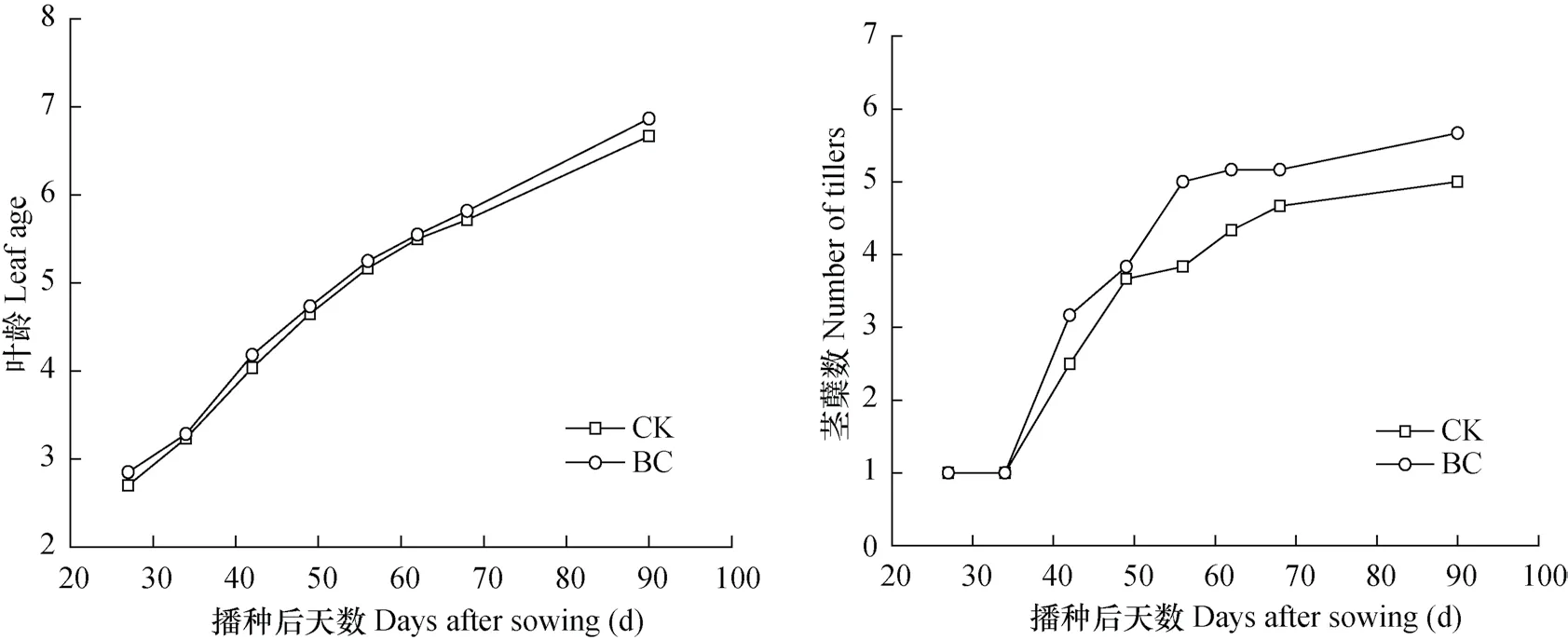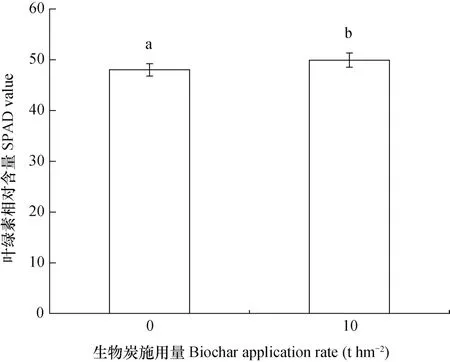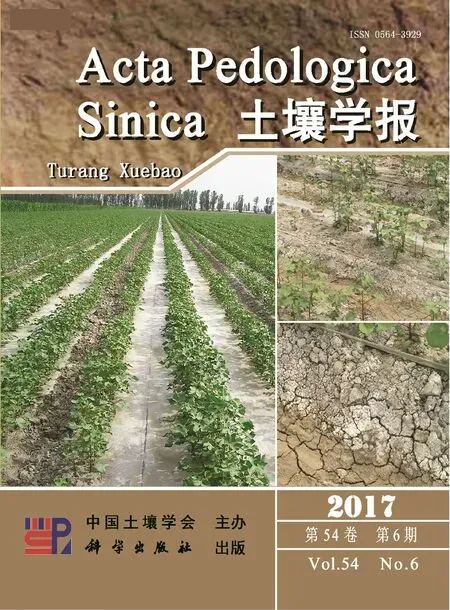生物炭缓解稻麦轮作区小麦渍害胁迫的作用*
刘 杨 刘晓宇 石春林 宣守丽 孙 彬
(1 农业信息研究所/农业部长江下游平原农业环境重点实验室,江苏省农业科学院,南京 210014)
(2 土壤与农业可持续发展国家重点实验室(中国科学院南京土壤研究所),南京 210008)
生物炭缓解稻麦轮作区小麦渍害胁迫的作用*
刘 杨1,2刘晓宇2石春林1†宣守丽1孙 彬1
(1 农业信息研究所/农业部长江下游平原农业环境重点实验室,江苏省农业科学院,南京 210014)
(2 土壤与农业可持续发展国家重点实验室(中国科学院南京土壤研究所),南京 210008)
稻麦轮作是长江中下游地区最主要的粮食生产方式,然而在该地区季风气候的背景下,小麦生长季易发生渍害胁迫,导致小麦减产甚至绝收。施用生物炭是一种有效的土壤改良方式,目前,已在长江中下游稻麦轮作区开展应用研究,但定量评估施用生物炭对长江中下游地区小麦渍害的影响研究尚未见报道。开展土柱和小区试验,研究水稻秸秆生物炭对稻麦轮作土壤和小麦生长前期的影响。结果表明,施用生物炭能显著降低稻麦轮作土壤的容重。不同深度的土壤水分动态变化也表明,施用生物炭有利于土壤水分向下迁移,可改善稻麦轮作土壤排水不畅的特点。同时,与未施用生物炭的处理相比,施用10 t hm-2生物炭能加快小麦出苗,促进小麦生长。播种后90 d的采样结果显示,施用生物炭处理下小麦株高、主根长和最后一片完全叶的叶绿素相对含量(SPAD值)均显著高于对照(p<0.05)。根系特征显示,施用生物炭处理下的小麦主根长虽然显著高于对照,但2个处理间的总根长和总根面积却无显著差异。综上,施用生物炭能显著改善稻麦轮作土壤的排水条件,促进小麦前期生长,将有助于小麦在关键生育期抵御渍害胁迫。
稻麦轮作;生物炭;渍害胁迫;土壤物理性质;土柱试验
稻麦轮作是长江中下游地区最主要的粮食生产方式[1],种植面积达到1 300万hm2[2],但这种水旱轮作制度往往导致土壤黏重、土壤排水性差[3]。在水稻生长季,稻麦轮作土壤较好的保水能力可节省水资源,提高水分利用效率,而小麦生长季一旦降雨过多,土壤水分难以排出,将导致严重的小麦渍害减产。受季风气候影响,每年3至5月为长江中下游地区阴雨多发季节[4],降水量往往超过小麦生长季的总需水量[5],是小麦渍害的高发时段。据报道[6-7],不同程度的渍害胁迫可造成小麦减产20%~50%。因此,渍害是长江中下游地区小麦生产面临的最主要的气象灾害之一,探索合理的方法降低小麦渍害减产对当地粮食安全有重要意义。
目前,应对小麦渍害减产的方法主要包括农田排水、渍后补施肥料及施用生长调节剂等[8-10]。这些方法主要分为两类,一类以土壤为处理对象,如加速排水、维持土壤肥力;另一类以作物为处理对象,如提高作物自身耐渍能力和渍后恢复能力。但农田排水成本较高,需要持续投入和维护[10];而补施肥料和使用生长调节剂,不但增加成本,且易造成面源污染[11]。在实际生产中,探索成本较低、环境友好的新方法具有重要意义。
生物炭(Biochar)是一种优良的土壤改良剂。生物炭是在完全或部分缺氧条件下,经热解产生的一种含碳量丰富、性质稳定的有机物质,具有多孔结构、低容重、高 pH等特征[12]。鉴于以上特性,生物炭在近年来被广泛用于改善土壤板结[13-14]、提高土壤碳固存[15]等。此外,相比秸秆直接还田,秸秆制成生物炭还田具有甲烷排放少以及不影响后续耕作、播种等优势[16]。目前,生物炭已在长江中下游稻麦轮作区开展应用研究[17]。但水稻秸秆生物炭对小麦生长,尤其是渍害胁迫背景下小麦生长的影响研究尚鲜见报道。已有研究表明,生物炭的多孔结构和低容重的特点有利于降低土壤容重、提高土壤孔隙度[14]。Peake等[13]针对8种类型土壤的研究表明,当生物炭施用量达到2.5%(w/w,生物炭与土壤的质量比)时,土壤容重下降4.2%~19.2%。Oguntunde等[18]采样调查的结果表明,施用生物炭使土壤容重降低9%。刘园等[19]在封丘开展的小区试验也表明,施用生物炭对土壤容重、水分、持水量等物理性状的改善可能是作物增产的重要原因。以上研究均表明,施用生物炭可降低土壤容重,增加土壤通气性[20],进而改良土壤结构[21]。因此,施用生物炭可能成为缓解小麦渍害胁迫的方法。然而,生物炭如何影响稻麦轮作土壤容重和土壤水分动态变化,能否改善土壤物理性质以解除土壤渍水状态,进而影响该种植制度下的小麦生产?相关研究尚较为缺乏。本研究通过开展土柱和小区试验,探索生物炭对稻麦轮作土壤和小麦前期生长的影响,为综合评价施用生物炭能否作为缓解小麦渍害胁迫的方法做前期评估。
1 材料与方法
1.1 供试材料
试验土壤取自江苏省农科院试验场附近(32°02′N,118°52′28″E)的稻麦轮作土壤(土壤类型为潴育型水稻土,质地为黏壤土),土壤容重为1.15 g cm-3,pH为 6.58。水稻秸秆生物炭购自江苏华丰公司,原料为水稻秸秆,烧制温度为500℃,容重为0.48 g cm-3。
1.2 土柱试验设计
2016年10月在江苏省农科院实验室内开展土柱试验,实验室温度控制在20℃。采用内径20 cm,高80 cm的聚氯乙烯(PVC)管制作土柱。分别在10、20和40 cm深处开一直径3 cm圆口,用于布设EC-5土壤水分传感器(Decagon Devices,美国)。PVC管底部钻取3个直径1 cm的圆口用于排水。试验共设置3个处理:生物炭施用量为0、10和40 t hm-2,使用收集的稻麦轮作土壤对20~80 cm深度的土柱进行填充,土壤和生物炭按比例混合后对0~20 cm深度的土柱进行填充。土柱装配完成后,将土壤水分调节至60%田间持水量,土壤水分达到平衡后维持7 d,之后模拟一次达到渍害水平的降水(40 mm),记录降水前后各层土壤的体积含水量,记录间隔为5 min。
1.3 小区试验设计
2016年11月在江苏省农科院试验场开展小区试验,小区大小为1.5 m×4.0 m。设置对照(CK,未施用生物炭)和施用生物炭(BC,施用量为10 t hm-2)2个处理,生物炭施用深度为0~20 cm,每处理均设置3个重复。小麦供试品种为宁麦13号。播种期为11月14日,采用行播的方式进行播种,每个小区播种7行,行距为20 cm,播种密度约为400粒 m-2。小区实行常规水肥管理,基肥施用量为纯氮135 kg hm-2(以复合肥的形式)。每个处理随机选取6株苗,用于监测小麦生长状况,每隔7 d左右记录小麦的叶龄和茎蘖数。小麦播种后90 d,对2个处理下的小麦进行取样分析,获取小麦各器官干物质重,同时测定小麦最后一片完全叶的叶绿素相对含量(SPAD)值,以及小麦主根长、总根长和总根面积。
1.4 指标测定
使用EC-5土壤水分传感器记录土柱试验模拟降水前后的土壤体积含水量,用模拟降水后的土壤体积含水量减去对应模拟降水前土壤水分平衡时的土壤体积含水量,获取土壤体积含水量变化量,用来描述降水后土壤水分动态变化。土柱模拟降水结束48 h后,在土柱10 cm深处,用环刀法测取土壤容重[22]。
播种后90 d对小区试验2个处理下的小麦植株进行取样,每个处理随机选取6株小麦,按根、茎、叶分样,105℃杀青30 min,80℃烘干至恒重,获取小麦各器官的干物质重。此外,采用叶绿素测定仪(SPAD-502,Minolta,日本),在小麦最后一片完全叶的中间部分测量4次,获取的平均值作为小麦叶片SPAD值,每个处理各选取5片叶片进行测量。采用WinRHIZO根系分析系统(Regent Instruments,Québec,加拿大),对小麦根系进行扫描,获取小麦总根长和总根面积,每个处理各选取5株小麦根系进行测量。
1.5 数据处理
采用方差分析比较土柱试验和小区试验中不同处理间的差异,均值的多重比较采用最小显著差异法(LSD)检验,p<0.05作为显著性差异的标准,统计分析使用SPSS 19.0进行。采用Origin 9.0进行制图。
2 结 果
2.1 生物炭处理下土壤容重变化
稻麦轮作土壤具有质地黏重、容重较大的特点,本研究中未经处理的稻麦轮作土壤容重达到1.15 g cm-3。当生物炭施用量达到10和40 t hm-2时,土壤容重相比对照分别下降7.4%和11.4%,均达到显著水平(p<0.05)(图1)。表明施用生物炭可降低土壤容重,改善稻麦轮作土壤较为黏重、紧实的特点。

图1 土柱试验中不同生物炭施用量下土壤容重变化Fig. 1 Variation of bulk density relative to application rate in soil column experiment
2.2 生物炭处理下土壤水分动态变化
土柱试验中,土壤水分动态变化表明,生物炭对不同层次土壤水分有不同影响(图2)。降水发生后,对照处理的10 cm土壤水分下降速度在初期(400 min内)低于施用生物炭的处理,表明相比对照,施用生物炭有利于土壤水分下渗。但模拟降水720 min左右,对照处理10 cm土壤水分继续下降,而施用生物炭处理下10 cm土壤水分变化较小。20 cm土壤水分的动态变化显示,对照处理20 cm土壤水分显著高于施用生物炭的处理。稻麦轮作土壤质地黏重,且在20 cm左右易出现紧实的犁底层,不利于土壤水分向下迁移。本试验的观测结果也显示,对照处理20 cm土壤水分在模拟降水后24 h内,明显高于施用生物炭的处理。生物炭处理20 cm土壤水分下降速度高于对照,在模拟降水60 min后,生物炭处理20 cm土壤水分已明显低于对照,表明施用生物炭可改善20 cm深度土壤的排水能力。相比10 cm和20 cm两个深度,各处理40 cm土壤水分动态变化趋势较为一致,无显著差异。
2.3 生物炭对小麦前期生长的影响
小区试验中,小麦生长前期监测结果显示,施用生物炭有利于小麦出苗。与对照(CK)相比,施用10 t hm-2生物炭的处理下(BC),小麦出苗时间提前3 d。此外,施用生物炭处理的小麦叶龄和茎蘖数也略高于对照,但两者之间的差异在播种后90 d内尚未达到显著水平(p>0.05,n=6)(图3)。
小麦播种后90 d,2个处理随机选取6株小麦进行破坏采样。采样结果显示,生物炭处理下小麦的株高和主根长均显著高于对照(p<0.05,n=6)(图4)。生物炭处理下的小麦茎和叶干重略高于对照,而根干重略低于对照,但处理间的差异均未达到显著水平(p>0.05,n=6)(数据未列出)。
使用SPAD-502叶绿素测定仪,在播种后90 d获取不同处理下小麦最后一片完全叶的SPAD值,结果表明,施用生物炭处理下小麦SPAD值显著高于对照处理(p<0.05,n=5)(图5),表明施用生物炭有助于提高小麦叶片叶绿素含量。
使用WinRHIZO根系分析系统,在播种后90 d获取不同处理下的小麦根系特征。结果显示,虽然生物炭处理下小麦主根长显著高于对照(图4),但总根长和总根面积却不存在显著差异(p>0.05,n=5)(图6)。

图2 不同生物炭施用量下不同深度(10、20、40 cm)土壤体积含水量动态变化Fig. 2 Dynamic change of soil volumetric water content at different soil depths(10 cm,20 cm,40 cm)relative to biochar application rate

图3 不同生物炭处理下小麦叶龄和茎蘖数变化Fig. 3 Variation of leaf age and number of tillers relative to biochar application rate

图4 播种后90 d不同生物炭处理下小麦株高和主根长Fig. 4 Plant height and taproot length of the plant 90 days after sowing relative to biochar application rate

图5 播种后90 d不同生物炭处理下小麦叶片叶绿素相对含量值Fig. 5 Chlorophyll relative content(SPAD values)of wheat leaves of the plant 90 days after sowing relative to biochar application rate

图6 播种后90 d不同生物炭处理下小麦总根长和总根面积Fig. 6 Total root length and total root area of the plant 90 days after sowing relative to biochar application rate
3 讨 论
3.1 施用生物碳对稻麦轮作区土壤物理性质的影响
前人研究[23]认为,土壤表层保持长时间积水,或土壤表层的有效水分较田间持水量高20%以上时,土壤达到渍水条件。水稻种植往往导致土壤透气性和排水性差[3],使得稻麦轮作土壤易达到渍水条件,在小麦生长季易发生渍害胁迫,导致小麦减产。因此,对质地较为黏重的稻麦轮作土壤进行改良,改善其排水能力,将有助于降低小麦渍害胁迫减产。已有研究表明,生物炭的多孔结构有利于降低土壤容重、提高土壤孔隙度[14]。本研究的结果也证明,施用水稻秸秆生物炭可显著降低土壤容重(图1),与前人研究结果一致[13]。当施用量达到10 t hm-2时,土壤容重下降7.4%,达到显著水平。当施用量增加至40 t hm-2时,土壤容重进一步下降。前人研究认为,生物炭具备较强的吸附能力,有利于改善土壤的保水能力,因此,生物炭最早用于干旱地区质地较粗土壤。而本研究的结果表明,生物炭同样可用于改善质地黏重的土壤。土壤水分动态变化的观测结果(图2)表明,施用生物炭有利于10 cm和20 cm土壤水分向下迁移。这主要是因为,生物炭具有疏松、多孔的结构,与土壤混合后,可增加土壤通气性[24],进而改善土壤排水能力[21]。因此,施用生物炭具备加速解除土壤渍水状态的潜力。此外,10 cm土壤水分动态变化的数据显示,生物炭一方面可促进排水,另一方面起到了土壤水分容器的作用。当水分过多时,生物炭可吸收一部分土壤水分,而水分下降到一定程度时,生物炭可释放之前吸收的水分,使土壤水分总体达到一个相对平衡的状态。进一步证明,生物炭作为一种优良的土壤改良剂,可同时适用于质地较粗和质地黏重的土壤。
3.2 施用生物炭对小麦根系的影响
土壤渍水后,土壤中的氧气快速下降,抑制根系的有氧呼吸,从而影响根系生长[25]。Malik等[26]采用盆栽试验的方法,研究不同持续时间渍害对小麦根系的影响,结果表明,渍害胁迫期间,小麦的种子根生长停滞,气根长度也受到抑制。因此,渍害胁迫往往抑制小麦根系生长。而前人研究[27]认为,施用生物炭有助于作物根系生长。张伟明等[28]开展的盆栽试验表明,施用生物炭能增加水稻生育前期根系的主根长、根体积和根鲜重,在一定程度上延缓根系衰老。这主要是因为,生物炭的多孔结构能降低土壤容重,提高土壤孔隙度[18],为根系生长提供较好环境,有利于根系深扎。本研究的试验结果也表明,施用生物炭显著降低土壤容重,促进根系深扎,因此,生物炭处理下小麦主根长显著高于对照(图4)。但2个处理间总根长和总根面积并无显著差异(图6),这可能是因为,生物炭处理下,小麦根系深扎可获取足够的水分,而对照处理下稻麦轮作土壤较为黏重,小麦根系难以向下深扎,迫使小麦根系横向生长,一定程度上弥补了总根长和总根面积。需进一步开展渍害胁迫试验,观测小麦根系特征,以明确生物炭在渍害胁迫下对小麦根系的影响。
3.3 施用生物炭对小麦叶片的影响
叶片是小麦进行光合作用的主要器官,渍害胁迫往往导致叶片氮含量和叶绿素含量下降,进而降低叶面积和叶片干物质重[26]。生物炭含有较丰富的氮元素,施用生物炭将有利于小麦叶片生长。Olmo等[29]开展的小区试验表明,施用生物炭可增加小麦叶片重量,在播种后187 d达到显著水平。本研究中,施用生物炭的处理下,小麦叶龄和小麦叶片干重高于对照,但播种后90 d内尚未达到显著水平(数据未列出),而施用生物炭处理下小麦叶片SPAD值显著高于对照(图5)。进一步证实,生物炭对小麦叶片有积极作用,有助于提高叶片叶绿素含量,促进小麦前期的生长。施用生物炭处理下,小麦叶片的这些特点可能有助于提高小麦的耐渍能力,但同样需要开展渍害胁迫试验进一步验证。
4 结 论
稻麦轮作土壤中施用水稻秸秆生物炭,具有降低土壤容重、改善土壤排水条件等作用。同时,施用生物炭处理下的小麦具有苗壮根深的特点。生物炭对土壤物理性状和小麦前期生长的影响,使得施用生物炭可成为抵御小麦渍害的潜在方法。后续研究将进一步观测渍害胁迫下施用生物炭对小麦的生理过程和产量的影响,以定量评估生物炭在降低小麦渍害中的潜力。
[1] Li C,Jiang D,Wollenweber B,et al. Waterlogging pretreatment during vegetative growth improves tolerance to waterlogging after anthesis in wheat. Plant Science,2011,180(5):672—678
[2] Yao Z,Zheng X,Wang R,et al. Nitrous oxide and methane fluxes from a rice-wheat crop rotation under wheat residue incorporation and no-tillage practices.Atmospheric Environment,2013,79:641—649
[3] 姜东,陶勤南,张国平. 渍水对小麦扬麦5号旗叶和根系衰老的影响. 应用生态学报,2002,13(11):1519—1521 Jiang D,Tao Q N,Zhang G P. Effect of waterlogging on senescence of flag leaf and root of wheat Yangmai 5(In Chinese). Chinese Journal of Applied Ecology,2002,13(11):1519—1521
[4] 石春林,金之庆. 基于 WCSODS的小麦渍害模型及其在灾害预警上的应用. 应用气象学报,2003,14(4):462—468 Shi C L,Jin Z Q. A WCSODS-based model for simulating wet damage for winter wheat in the middle and lower reaches of the Yangtse River(In Chinese).Journal of Applied Meteorological Science,2003,14(4):462—468
[5] Jiang D,Fan X,Dai T,et al. Nitrogen fertiliser rate and post-anthesis waterlogging effects on carbohydrate and nitrogen dynamics in wheat. Plant and Soil,2008,304(1/2):301—314
[6] Arguello M N,Mason R E,Roberts T L,et al.Performance of soft red winter wheat subjected to field soil waterlogging:Grain yield and yield components.Field Crops Research,2016,194:57—64
[7] 刘杨,石春林,宣守丽,等. 不同生育期渍水寡照对小麦产量构成的影响. 江苏农业科学,2016,44(10):124—127 Liu Y,Shi C L,Xuan S L,et al. Effect of waterlogging and shading at different stages on yield component of winter wheat(In Chinese). Jiangsu Agricultural Sciences,2016,44(10):124—127
[8] Rasaei A,Ghobadi M E,Jalali-Honarmand S,et al.Impacts of waterlogging on shoot apex development and recovery effects of nitrogen on grain yield of wheat.European Journal of Experimental Biology,2012,2(4):1000—1007
[9] 范雪梅,姜东,戴廷波,等. 花后干旱和渍水下氮素供应对小麦旗叶衰老和粒重的影响. 土壤学报,2005,42(5):875—879 Fan X M,Jiang D,Dai T B,et al. Effects of nitrogen supply on flag leaf senescence and grain weight in wheat grown under drought or waterlogging from anthesis to maturity(In Chinese). Acta Pedologica Sinica,2005,42(5):875—879
[10] 朱建强,乔文军,刘德福,等. 农田排水面临的形势、任务及发展趋势. 灌溉排水学报,2004,23(1):62—65 Zhu J Q,Qiao W J,Liu D F,et al. Situation and tasks of farmland drainage facing,and its tendency(In Chinese). Journal of Irrigation and Drainage,2004,23(1):62—65
[11] Zhao X,Zhou Y,Min J,et al. Nitrogen runoff dominates water nitrogen pollution from rice-wheat rotation in the Taihu Lake region of China. Agriculture,Ecosystems amp; Environment,2012,156:1—11
[12] 谢祖彬,刘琦,许燕萍,等. 生物炭研究进展及其研究方向. 土壤,2011,43(6):857—861 Xie Z B,Liu Q,Xu Y P,et al. Advances and perspectives of biochar research(In Chinese). Soils,2011,43(6):857—861
[13] Peake L R,Reid B J,Tang X. Quantifying the influence of biochar on the physical and hydrological properties of dissimilar soils. Geoderma,2014,235:182—190
[14] Verheijen F,Jeffery S,Bastos A. Biochar application to soils:A critical scientific review of effects on soil properties,processes and functions. Luxembourg:Office for the Official Publications of the European Communities,2010
[15] Mukherjee A,Zimmerman A R. Organic carbon and nutrient release from a range of laboratory-produced biochars and biochar–soil mixtures. Geoderma,2013,193:122—130
[16] Zhao X,Wang J,Wang S,et al. Successive straw biochar application as a strategy to sequester carbon and improve fertility:A pot experiment with two rice/wheat rotations in paddy soil. Plant and Soil,2014,378(1/2):279—294
[17] Feng Y,Sun H,Xue L,et al. Biochar applied at an appropriate rate can avoid increasing NH3volatilization dramatically in rice paddy soil. Chemosphere,2017,168:1277—1284
[18] Oguntunde P G,Abiodun B J,Ajayi A E,et al.Effects of charcoal production on soil physical properties in ghana. Journal of Plant Nutrition and Soil Science,2008,171(4):591—596
[19] 刘园,Khan M J,靳海洋,等. 秸秆生物炭对潮土作物产量和土壤性状的影响. 土壤学报,2015,52(4):849—858 Liu Y,Khan M J,Jin H Y,et al. Effects of successive application of crop-straw biochar on crop yield and soil properties in cambosols(In Chinese). Acta Pedologica Sinica,2015,52(4):849—858
[20] Case S D C,McNamara N P,Reay D S,et al. The effect of biochar addition on N2O and CO2emissions from a sandy loam soil – The role of soil aeration. Soil Biology amp; Biochemistry,2012,51:125-134
[21] Jeffery S,Verheijen F G A,van der Velde M,et al. A quantitative review of the effects of biochar application to soils on crop productivity using meta-analysis.Agriculture Ecosystems amp; Environment,2011,144(1):175—187
[22] 鲁如坤. 土壤农业化学分析方法. 北京:中国农业科学技术出版社,2000 Lu R K. Analytical methods for soil and agro-chemistry(In Chinese). Beijing:China Agricultural Science and Technology Press,2000
[23] Aggarwal P K,Kalra N,Chander S,et al. Infocrop:A dynamic simulation model for the assessment of crop yields,losses due to pests,and environmental impact of agro-ecosystems in tropical environments. I. Model description. Agricultural Systems,2006,89(1):1—25
[24] Brassard P,Godbout S,Raghavan V. Soil biochar amendment as a climate change mitigation tool:Key parameters and mechanisms involved. Journal of Environmental Management,2016,181:484—497
[25] Gibbs J,Greenway H. Review:Mechanisms of anoxia tolerance in plants. I. Growth,survival and anaerobic catabolism. Functional Plant Biology,2003,30(1):1—47
[26] Malik A I,Colmer T D,Lambers H,et al. Shortterm waterlogging has long-term effects on the growth and physiology of wheat. New Phytologist,2002,153(2):225—236
[27] Gul S,Whalen J K. Biochemical cycling of nitrogen and phosphorus in biochar-amended soils. Soil Biology amp;Biochemistry,2016,103:1—15
[28] 张伟明,孟军,王嘉宇,等. 生物炭对水稻根系形态与生理特性及产量的影响. 作物学报,2013,39(8):1445—1451 Zhang W M,Meng J,Wang J Y,et al. Effect of biochar on root morphological and physiological characteristics and yield in rice(In Chinese). Acta Agronomica Sinica,2013,39(8):1445—1451
[29] Olmo M,Alburquerque J A,Barrón V,et al. Wheat growth and yield responses to biochar addition under mediterranean climate conditions. Biology and Fertility of Soils,2014,50(8):1177—1187
(责任编辑:陈荣府)
Effect of Biochar Alleviating Waterlogging Stress of Winter Wheat in Rice-Wheat Rotation Systems
LIU Yang1,2LIU Xiaoyu2SHI Chunlin1†XUAN Shouli1SUN Bin1
(1 Institute of Agricultural Information/Key Laboratory of Agricultural Environment in Lower Reaches of the Yangtze River,MOA,Jiangsu Academy of Agricultural Sciences,Nanjing 210014,China)
(2 State Key Laboratory of Soil and Sustainable Agriculture,Institute of Soil Science,Chinese Academy of Sciences,Nanjing 210008,China)
【Objective】Crop rotation of rice and winter wheat is a common farming practice in areas of the middle and lower reaches of the Yangtze River. However,the paddy soils under such a cropping system are always heavy in texture,and tend to bring about waterlogging stress to the crop of winter wheat during its growing season under monsoon climate of winter wheat,thus inducing severe yield losses or loss of the whole crop. It is,therefore,essential to seek for a low cost and environment friendly method to alleviate yield losses caused by waterlogging stress for the sake of local food security. Biochar is an effective soil amendment and can be used to reduce soil hardening and enhance soil organic carbon sequestration. Nowadays,researches have has been carried out on application of biochar in areas under the crop rotation system in the middle and lower reaches of the Yangtze River. However,little has been reported on quantitative evaluation of the effect of biochar alleviating waterlogging stress of winter wheat in South China.【Method】Therefore,in the present study,soil column and plot experiments were conducted to investigate effects of application of biochar derived from rice straw in paddy fields under the rotation system on growth of winter wheat at its early stage,in an attempt to obtain a preliminary evaluation of the prospects of biochar application to alleviate waterlogging stress. Effects of biochar application varying in rate on soil bulk density and soil water content at different depths were evaluated through the soil column experiment,and its effects on wheat germination and wheat growth at early stage were through the plot experiment.【Result】Results show that biochar application significantly reduced bulk density of the soil. When biochar was applied at a rate of 10 and 40 t hm-2,soil bulk density was lowered by 7.4% and 11.4%,respectively,compared with CK(the treatment with no biochar applied). Dynamics of the soil in water content varied with soil depth. biochar application facilitated soil water percolation,thus alleviating the risk of waterlogging. Specifically,in the soil applied with biochar,soil water content at 20 cm in depth dropped rapidly after a simulated rainfall event compared with that in CK. The changes in physical properties of the soil applied with biochar indicated that drainage conditions of the soil were improved,favoring growth of winter wheat. In addition,compared with CK,biochar application at a rate of 10 t hm-2(BC)accelerated seed germination and promoted wheat growth at its early stage. Samples of winter wheat were collected on D90 after sowing for analysis of plant height,taproot length and chlorophyll relative content(SPAD value)of the new fully expanded leaf. It was found that they were all significantly higher in the treatments applied with biochar than in CK(p<0.05). The findings fully demonstrate that biochar application is beneficial to wheat growth at its early stage. However,its effects on dry matter weight of root,stem and leaf were not significant. In terms of characteristics of the root system,the plants in the biochar treatments had longer taproot than those did in CK,but did not differ much in total root length and total root area,which may be explained by the heavy texture of the soil CK. In such soils,the plant can not have its taproot go deep and for compensation have more lateral roots developed for water and nutrient absorption.【Conclusion】On the whole,biochar application can significantly improve drainage of the soil under crop rotation and benefit growth of the wheat at its early stage. All the findings listed above demonstrate that biochar application has the potential to alleviate waterlogging stress. However,further efforts should be made to study effects of biochar application on physiology and yield of winter wheat subjected to waterlogging so as to validate the hypothesis.
Rice-wheat rotation;Biochar;Waterlogging stress;Soil physical property;Soil column experiment
S156.3;S166
A
10.11766/trxb201705120210
* 国家公益性行业(农业)科研专项项目(201203032)、江苏省农业科学院院基金(6111647)和江苏省农业科技自主创新基金项目(CX(16)1042)资助 Supported by the Special Fund for Agro-scientific Research in the Public Interest(No.201203032),the Fund of Jiangsu Academy of Agricultural Sciences(No. 6111647),and the Fund for Independent Innovation of Agricultural Sciences in Jiangsu Province(No. CX(16)1042)
† 通讯作者 Corresponding author,E-mail:shicl@ jaas.ac.cn
刘 杨(1986—),男,江西宜春人,博士研究生,研究方向为气候变化和土壤碳循环。E-mail:luisyang@126.com
2017-05-12;
2017-06-06;优先数字出版日期(www.cnki.net):2017-06-27

